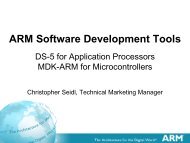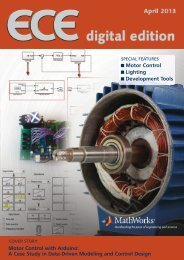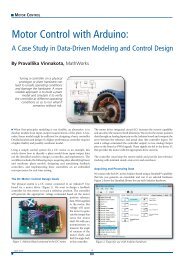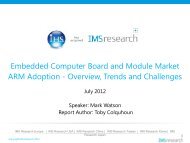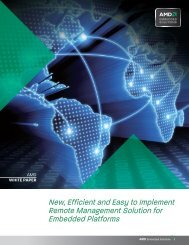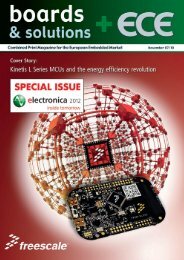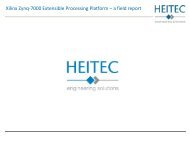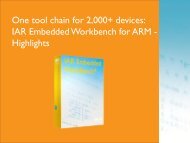AMD G-Series SOC integrates CPU, GPU and I ... - ICC Media GmbH
AMD G-Series SOC integrates CPU, GPU and I ... - ICC Media GmbH
AMD G-Series SOC integrates CPU, GPU and I ... - ICC Media GmbH
- No tags were found...
You also want an ePaper? Increase the reach of your titles
YUMPU automatically turns print PDFs into web optimized ePapers that Google loves.
TANSPORTATIONComputer systems for railwayapplicationsBy Barbara Schmitz, MEN Mikro ElektronikMore <strong>and</strong> more electronicsystems are being built intotrains, the underground,streetcars <strong>and</strong> buses. If youtalk about the overall railwayengineering market, youdon’t only mean vehicles – inwhich areas <strong>and</strong> applicationscan one find these computers<strong>and</strong> which functions do theytake over? And why are theyso different to the office PCor the one at home?Figure 1. Redundant railsignalling system in 2oo3architecture Common studies like that of the SCI Verkehrroughly divide the railway market into vehicles,system technology <strong>and</strong> infrastructure. Whilethe overall market has a volume of 143 billioneuros (according to UNIFE 2012 for 2011),about 60% of the business amounts to vehicles,just over 30% to infrastructure <strong>and</strong> less than10% to system technology. The term infrastructureincludes the track system <strong>and</strong> electrificationwhere no computers are needed.System technology comprises traffic management<strong>and</strong> train protection as well as informationtechnology, including passenger information,passenger safety <strong>and</strong> fare management.In all areas computers are of vital importance.What’s obvious in passenger information,which is customer-oriented to meet the usualconvenience <strong>and</strong> st<strong>and</strong>ard of living, has to beclarified for traffic management <strong>and</strong> train protection.Ever increasing speeds with more <strong>and</strong>more dense traffic on the track <strong>and</strong> finally theharmonization of rail networks across countries(ERTMS, CRTMS, PTC) as well as the increasein safety <strong>and</strong> economic efficiency would beimpossible to achieve without powerful computerson the wayside <strong>and</strong> in the railwaycontrol center or in the central control room.This makes system technology the smallestbut fastest growing segment of the railwaymarket – not just in Asia, with a market shareof over 30%, but also in Western Europe (insecond place with almost 30%) <strong>and</strong> NorthAmerica/NAFTA (third place with nearly 20%).While UNIFE assumes that the entire worldwidemarket will annually grow by 2.0% to2.5% until 2015/16, it expects an annual growthof 6% for traffic management <strong>and</strong> train protection,<strong>and</strong> of 4% for information technology.Let’s go back to the vehicles, which take up almosttwo thirds of the global market volume.The average annual growth rates depend onthe vehicle type <strong>and</strong> country (<strong>and</strong> new acquisitionor maintenance) <strong>and</strong> are between 0 <strong>and</strong>4%. The biggest driving force behind this liesin equipping the vehicles with computers fortrain protection <strong>and</strong> control. Of course, thecomputers on board the vehicles fulfil manyother tasks, too. These include the control ofvital functions (e.g. drive, brake, power supply,tilting technology), safety management (doors,light, etc), <strong>and</strong> convenience functions (heating,air conditioning, etc) inside the vehicle.If you compare a computer inside a rail vehicleor in train protection with computers in otherembedded applications, you will see two strikingdifferences. On one h<strong>and</strong>, electronics for arailway-compliant control have to meet moresevere requirements with respect to robustness,reliability <strong>and</strong> availability, <strong>and</strong> dem<strong>and</strong> correspondingprecautions <strong>and</strong> thorough knowledgein design, production, qualification <strong>and</strong> productcare. The EN 50155 st<strong>and</strong>ard defines rules regardingdifferent environmental impacts. Theoperating temperature is divided into twoclasses. Tx prescribes that the computer canbe operated between -40°C <strong>and</strong> +70°C, for example,<strong>and</strong> for 10 minutes even up to +85°C.The electronics in the system must be coatedby a special varnish for protection against humidityor condensation. It may also be necessaryto protect the housing against splashingwater. The st<strong>and</strong>ard also prescribes shock <strong>and</strong>vibration tests over a specific frequency range.In addition to common EMC inspections, thebehaviour in case of overvoltage is tested. Failure-freeoperation of electronics must be guaranteedeven with supply voltages between 70%<strong>and</strong> 125% of the nominal voltage. The basicmaterial for printed circuit boards is definedwith regard to flammability. Solder connectionsor other connections with insulation displacementare subject to the respective st<strong>and</strong>ards,<strong>and</strong> so on.Depending on the application, only parts ofthe EN 50155 st<strong>and</strong>ard need be observed, orelse all of its provisions. The European DINEN 50155 st<strong>and</strong>ard (German VDE 0115, internationalIEC 571-x) „Railway applications -Electronic equipment used on rolling stock“is issued by the European organization forelectro-technical st<strong>and</strong>ardization, CENELEC,<strong>and</strong> was first published in 1995. It is very de-May 2013 8



